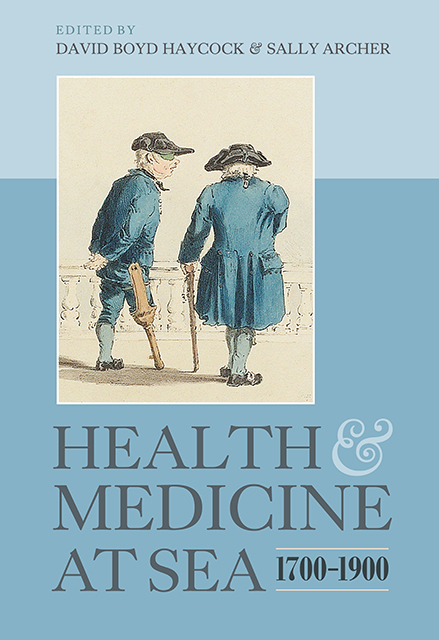Book contents
- Frontmatter
- Contents
- List of Figures and Tables
- Preface
- List of Contributors
- Acknowledgements
- List of Abbreviations
- Introduction Health, Medicine and the Maritime World: A History of Two Centuries
- 1 ‘The Intention is Certain Noble’: The Western Squadron, Medical Trials, and the Sick and Hurt Board during the Seven Years War (1756–63)
- 2 Royal Navy Surgeons, 1793–1815: A Collective Biography
- 3 Surgery in the Royal Navy during the Republican and Napoleonic Wars (1793–1815)
- 4 The Sick and Hurt Board: Fit for Purpose?
- 5 An ‘Important and Truly National Subject’: The West Africa Service and the Health of the Royal Navy in the Mid Nineteenth Century
- 6 Mortality and Migration: A Survey 128
- 7 Slave Purchasing Strategies and Shipboard Mortality: Day-to-Day Evidence from the Dutch African Trade, 1751–1797
- 8 Ships, Families and Surgeons: Migrant Voyages to Australia in the Age of Sail
- 9 Medical Encounters on the Kala Pani: Regulation and Resistance in the Passages of Indentured Indian Migrants, 1834–1900
- Bibliography
- Index
4 - The Sick and Hurt Board: Fit for Purpose?
Published online by Cambridge University Press: 07 March 2023
- Frontmatter
- Contents
- List of Figures and Tables
- Preface
- List of Contributors
- Acknowledgements
- List of Abbreviations
- Introduction Health, Medicine and the Maritime World: A History of Two Centuries
- 1 ‘The Intention is Certain Noble’: The Western Squadron, Medical Trials, and the Sick and Hurt Board during the Seven Years War (1756–63)
- 2 Royal Navy Surgeons, 1793–1815: A Collective Biography
- 3 Surgery in the Royal Navy during the Republican and Napoleonic Wars (1793–1815)
- 4 The Sick and Hurt Board: Fit for Purpose?
- 5 An ‘Important and Truly National Subject’: The West Africa Service and the Health of the Royal Navy in the Mid Nineteenth Century
- 6 Mortality and Migration: A Survey 128
- 7 Slave Purchasing Strategies and Shipboard Mortality: Day-to-Day Evidence from the Dutch African Trade, 1751–1797
- 8 Ships, Families and Surgeons: Migrant Voyages to Australia in the Age of Sail
- 9 Medical Encounters on the Kala Pani: Regulation and Resistance in the Passages of Indentured Indian Migrants, 1834–1900
- Bibliography
- Index
Summary
The Sick and Hurt Board (formally titled the Commissioners for taking Care of Sick and Wounded Seamen and for the Care and Treatment of Prisoners of War) had first been created during the Dutch Wars of the mid seventeenth century. Fresh commissions were formed at the beginning of the succeeding wars, and dissolved at the peace. From 1715 the commissioners (there were only two) were members of the Navy Board, who were assigned these additional duties, though there was little work for them to do in these years of peace. It was not until 1740 that a new commission was established to deal with the increasing business created by the war with Spain. Henceforth the Board, though reduced in peacetime, remained a permanent department of the Royal Navy – though this permanence seems rather to have been the result of regular eighteenth-century wars than any deliberate decision by the government. But as the French Wars of the late eighteenth century progressed, and the size of the Royal Navy increased, it came under increasing strain and gathering scrutiny and criticism from the Admiralty and the government, with accusations that it was ‘unfit for purpose’. In 1806 it was abolished. This chapter re-examines the history of the Sick and Hurt Board and the role it played in maritime health, and suggests that the perceived failings of the Board had, in fact, much to do with departmental policies and practices in the Royal Navy, and their political considerations, than with a lack of vision on the part of its commissioners.
In the early years of permanence the commissioners were bureaucrats whose earlier careers were formed within naval administration, and they had no medical qualifications. The Board was responsible for the care of sick and wounded seamen ashore, making regular returns of the numbers of such men to the Navy Board (which was responsible for administrative matters, such as the dockyards, pay and victualling) and the Board of Admiralty (which was responsible for appointments and operational matters). The Sick and Hurt Board was responsible for overall supervision of the contracts made for sick quarters ashore, negotiated locally through their agent, or abroad by the senior sea officer; it was also responsible for the furnishing and equipping of contract hospitals and hospital ships, and later, when the Navy started building its own hospitals from the 1740s, for their supervision.
- Type
- Chapter
- Information
- Health and Medicine at Sea, 1700-1900 , pp. 90 - 107Publisher: Boydell & BrewerPrint publication year: 2009



